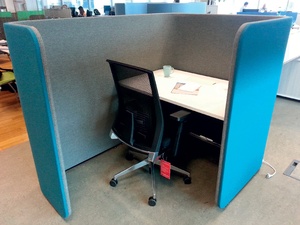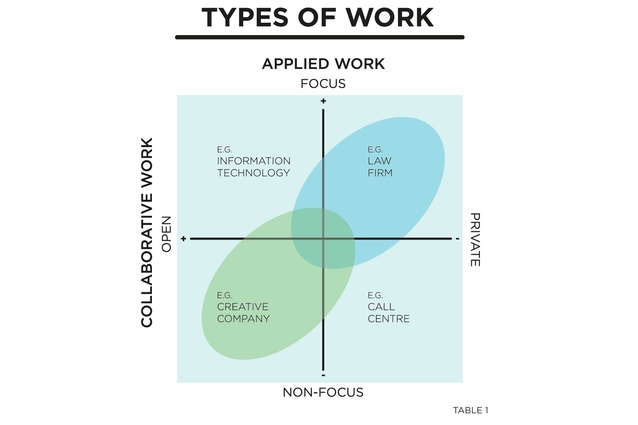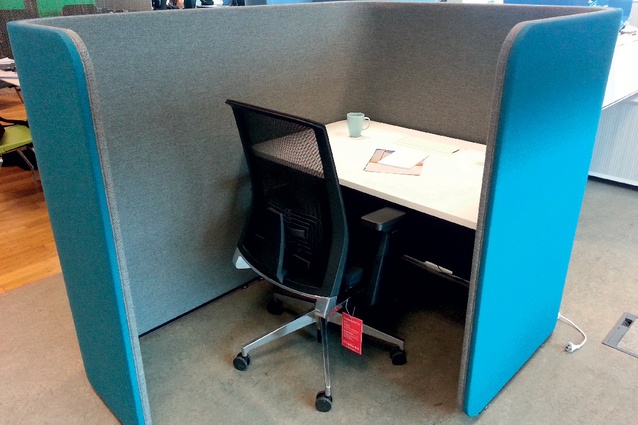Noise – Infusion or confusion
Open collaborative spaces are great – sometimes – but a new study shows that office workers spend up to a quarter of their day affected by audible interruptions and distractions.
We all know that collaboration is the most viable way to harvest the knowledge resident in our best companies. Increasingly this knowledge is harvested in less formal interactions. Unplanned interactions amongst colleagues remain the ripe ground upon which teams can increasingly advance the company’s goals.
Knowledge that is openly discussed in these unplanned interactions moves in a diffusion-style transfer from those who have it to those who want it – even if they don’t know they want it.
How many times per day do we over hear another conversation at work? Our ability to intercept a conversation and contribute enhances the productivity of teams by enabling results that would otherwise require formal process (research, meetings etc.).
But consider this – this process of infusing team members with the expertise resident in team members with diverse knowledge is not only valuable, it is also ironically harmful.
Research shows that focus works remains 40% to 60% of our daily work life. So the audibility of this knowledge transfer may be welcome to some, but to others involved in focus work it will be harmful.
According to a new Basex study, office workers spend a quarter of their day consumed by interruptions and distractions – wasting time and money (Wallis, Steptoe, & Cole, 2006). This study determined that this constant splintering and diverting of worker attention consumed up to 2.1 hours of worker productivity per day. These lost hours included not only interruptions and distractions but also the recovery time associated with getting back on task.
Hearing is one of the most acute senses. The human ears are incredibly sensitive in the audible frequency range (20Hz to 20kHz). From the threshold less than one billionth of atmospheric pressure to an incredible power range of 10 13. The range of sound we can hear is phenomenal; some people can literally hear a pin drop and yet most can still tolerate sounds such as heavy machinery. Levels of loudness that cause discomfort differ from person to person and can also be affected by a person’s mood, for example we may be less tolerant of loud sounds if we are stressed.
In the office environment, sound affects people in different ways. Numerous studies have confirmed that noise has a significant negative impact on the ability to concentrate. Noise exposure can also have after effects such as build up of stress and reduced tolerance or frustration.
While over half of office workers surveyed report feeling disturbed by frequent conversations and other distractions, some people are more disturbed by such interruptions than others. Introverts and participants who rate themselves as “noise sensitive” do more poorly than other subjects when tested in the presence of noise. Extroverts often prefer to study in the presence of noise or music, while introverts prefer quiet. However, under many test conditions, both introverts and extroverts are adversely affected by noise.
In general, people are more annoyed and distracted by sounds they consider unnecessary (idle chit-chat) than by sounds they view as inevitable (keyboard noise, for instance). Also, unexpected sounds and noises generated by others tend to be more annoying than sounds that are predictable and under the individual’s control. In fact, noise can be thought of as “any unwanted sound created by another person.”
Speech is considered the most annoying and distracting type of office noise. How do we combat this?
Different types of businesses require different workplace design strategies. Table 1, left, suggests a way to segment the way cognitive work is performed. For a litigation or legal firm, the large proportion of work will be done in a focus manner with private/confidential collaborations. Contrast this with creative firms who thrive in open, energised collaborative spaces and a mix of focus/non-focus work. Each of these companies requires a different strategy to balance the value creating process with the acoustic requirements of the space.
Here are some strategies that can be considered:

1/ Create zones:
Activity-based working is now a well accepted design strategy providing destination spaces for those who need to focus through to energized and activated spaces. Acoustic strategies can provide passive absorbing for destination-focus spaces or in the collaborative spaces.
2/ Get Active:
Consider the role of background noise which can provide masking properties to assist in speech privacy.
In the ASB North Wharf building, the HVAC noise could not be used as the background noise as it is passively ventilated. However, in this case background noise created from babble (multi-talkers) in the large atrium feeds into the adjacent neighborhoods. This strategy is generally only effective with a large number of occupants (500 or more).
Malcolm Dunn, from Marshall Day Acoustics, says this acoustic hum is equivalent to that of an airport’s natural hum. The advantage, says Malcolm, of natural masking is that higher levels of masking noise 48dB(A) can be achieved using this method. Electronic masking has a lower threshold 36dB(A) where people become annoyed. A massive 12 dB(A) difference is extremely significant in improving speech privacy between occupants in large spaces.

3/ Get above it:
Careful consideration of sound-absorbing products in the ceiling plane can provide acoustic dampening of a space. In these types of environments, an absorptive ceiling with a Noise Reduction Coefficient (NRC) of 0.9 is highly recommended.
If there is no absorption in the ceiling plane, soft furnishings provide additional absorption as well as diffusing the sound.
In smaller, open-plan environments, designers should give careful consideration to vertical acoustic wall panels to reduce lateral sound reflections. This is important in both medium to large meeting rooms to eliminate flutter echoes. Flutter echoes are sound waves bouncing back and forth between walls especially if the walls are parallel and have no absorption, e.g plaster walls.
4/ The psychology of space:
Screens have played an interesting role in the evolution of acoustic requirements. Beyond dispute, the most effective acoustic strategy is to have occupants adjust their own behavior. Where screens prevent occupants seeing another co-worker, the sound levels tend to rise. When all residents have immediate eye contact, the voice levels will modulate at a lower level due to human response and body language. In these cases, The height of the screens is a very important parameter.
5/ Get up and go.
There is an increasing use of furniture instead of walls to create acoustic pods, as seen in image 1, that provide a destination solution for focused work. These destination pieces of furniture provide several benefits. The acoustic benefits of filtering out external speech-frequency noise enhances the ability to focus. Importantly, the mere fact of being situated in one of these areas sends a signal to co workers that you intend to focus and to reconsider interruptions to this particular style of work.
6/ Emerging technologies
Nanofibre technology is being explored as acoustical damping in composite materials. Electrospun polyacrylonitrile (PAN), nanofibrous membranes within composite materials, lower the first absorption resonance which provides additional sound absorption.
Active noise control (ANC), also known as noise cancellation, or active noise reduction (ANR), is a method for reducing unwanted sound by the addition of a second sound specifically designed to cancel the first. Modern active noise control is generally achieved through the use of analog circuits or digital signal processing. Adaptive algorithms are designed to analyse the waveform of the background aural or nonaural noise, then based on the specific algorithm generate a signal that will either phase shift or invert the polarity of the original signal. This inverted signal (in antiphase) is then amplified and a transducer creates a sound wave directly proportional; to the amplitude of the original waveform, creating destructive interference. This effectively reduces the volume of the perceivable noise.
Summary
Whatever the size of the company, the need for open collaborations is growing in importance. Larger companies will benefit in a greater proportion due to the greater role of specialisation. However, small and medium size companies will also benefit from open-plan and activity-based working. The infusion of specialist knowledge throughout the team will maximise the productivity of a firm. However, well-considered acoustic strategies are vital in ensuring the infusion process does not become a confusion process.












